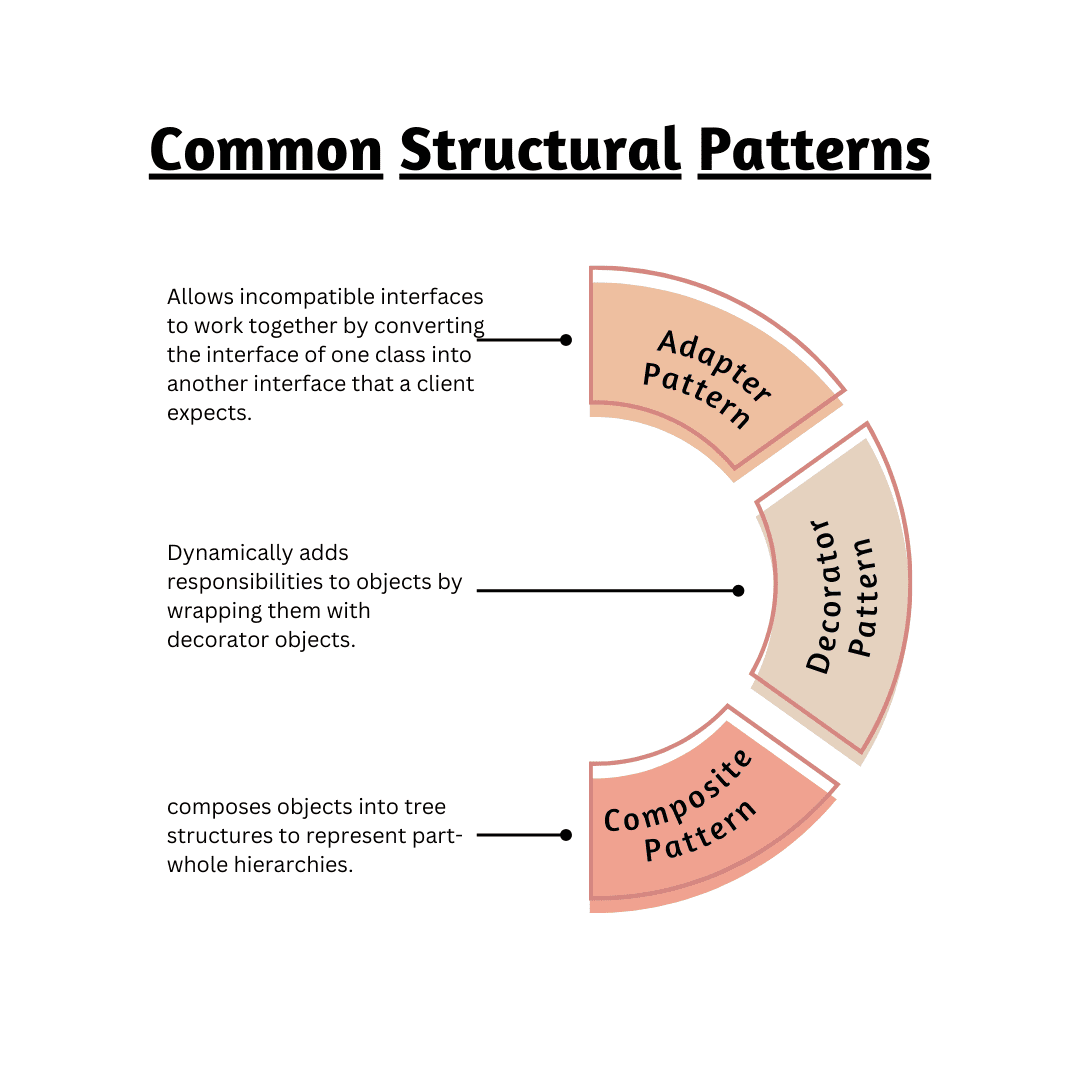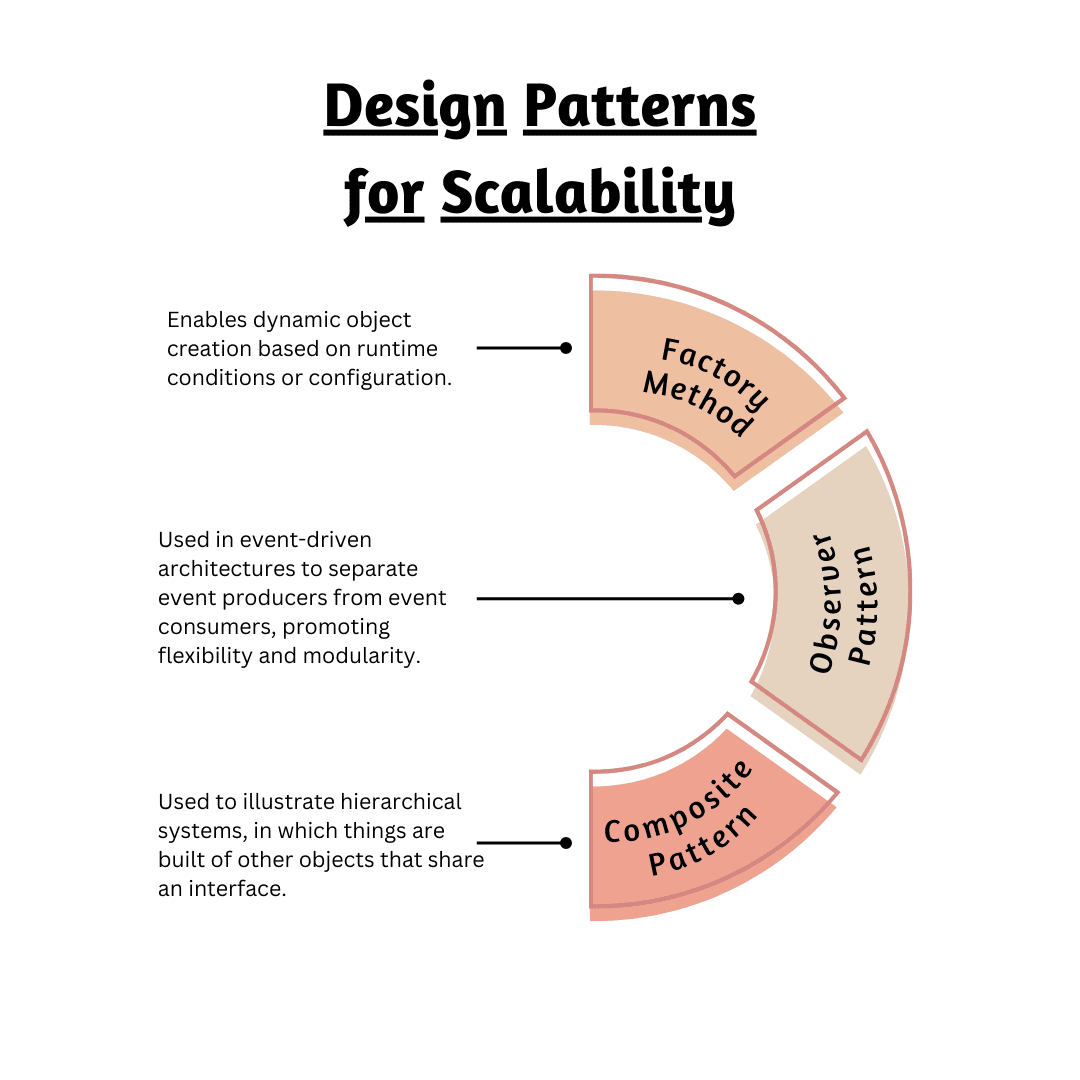Design patterns act as the secret ingredient that enhances code quality, ensures maintainability, and encourages scalability in the ever-evolving world of software development. Let’s ponder over the vibrant realm of design patterns and evaluate how these patterns form the basis of building high-performance software systems.
Design patterns are proven solutions to recurring problems in software development process. They incorporate best practices and serve as a blueprint for addressing common architectural challenges. The main objective of design patterns is to make code more reusable, flexible, and maintainable by promoting modularity and separation of concerns.
Types of Design Patterns
Design patterns in software development offer broad, recurring solutions to typical challenges encountered during the design phase of software creation. The three main categories of design patterns are creational, structural, and behavioral.

i) Creational Patterns
Creational patterns deal with object creation mechanisms, abstracting the instantiation process to make a system independent of how its objects are created, composed, and represented. These patterns result in improving flexibility and reusability as they emphasize effective methods for producing objects while concealing the logic involved.
Common creational patterns include: –

- The Singleton Pattern: The Singleton Pattern ensures that a class has only one instance and provides a global access point to that instance. It is useful in cases where only one instance of a class is required across the entire application, such as for managing resources like configuration settings or database connections.
- Factory Method Pattern: Defines an interface for creating objects but allows subclasses to determine the type of objects that will be created. It facilitates loose coupling and improves flexibility by offering the instantiation logic to subclasses, promoting loose coupling.
- Abstract Factory/Builder Pattern: Provides an interface for creating families of related or dependent objects without specifying their concrete classes. It improves flexibility and interchangeability by enabling the creation of objects belonging to several related classes without explicitly defining their classes.
ii) Structural Patterns
Structural patterns simplify and optimize interactions between classes or objects. These patterns help to ensure that if one part of a system changes, the entire system doesn’t need to do so as well.
Common structural patterns include: –

- Adapter Pattern: Allows incompatible interfaces to work together by converting the interface of one class into another interface that a client expects. Helps integrate systems with conflicting interfaces.
- Decorator Pattern: Dynamically adds responsibilities to objects by wrapping them with decorator objects. It enables the addition of behavior to individual objects without affecting other objects in the same class, improving code reuse and flexibility.
- Composite Pattern: Composes objects into tree structures to represent part-whole hierarchies. Clients can handle individual objects and compositions consistently, allowing for the creation of complex structures from basic ones.
iii) Behavioral Patterns
Behavioral patterns center on the communication between objects, specifying how objects interact and delegate responsibilities among themselves. These patterns help in defining algorithms and enable flexible communication among classes.
Common behavioral patterns include: –

- Observer Pattern: Defines a one-to-many dependency between objects so that when one object changes state, all its dependents are notified and updated automatically. It is useful for implementing distributed event handling systems.
- Strategy Pattern: Defines a family of algorithms, encapsulates each one, and makes them interchangeable. It allows the algorithm to vary independently from the clients that use it, which further promotes flexibility and extensibility.
- Chain of Responsibility Pattern: Creates a chain of processing objects, where each object in the chain can process the request or pass it on to the next object in the chain. It is beneficial for implementing event-driven architectures. This way, multiple objects can handle the same event in various ways.
Applying Design Patterns for Scalability
Design patterns ensure that a system can manage increasing demands such as more users, interactions, and data while maintaining speed and responsiveness. With patterns like the factory method and strategy, developers can adjust the system to meet new needs without redoing all the code.
Additionally, patterns like the Factory Method, Observer, and Composite help with scalability, simplifying the design of systems that can expand seamlessly by enabling efficient communication and collaboration among objects.

Factory Method for Dynamic Object Creation
The Factory Method pattern is a type of design pattern used for creating objects. It sets up an interface in a main class for creating objects, but lets subclasses change the type of objects that will be made. “This design pattern is especially valuable for scalability because it enables dynamic object creation based on runtime conditions or configuration.”
In a scalable system, the Factory Method pattern can be employed to instantiate objects dynamically based on changing requirements or load conditions. For example, in a web application handling varying levels of traffic, different implementations of a service may be required to accommodate the load. The Factory Method pattern creates service instances based on current demand, ensuring efficient use of resources and scalability.
Observer Pattern for Event-Driven Scalability
The observer pattern is a behavioral design pattern that defines a one-to-many dependency between objects so that when one object (the subject) changes state, all its dependents (observers) are notified and updated automatically. This pattern is commonly used in event-driven architectures to separate event producers from event consumers, promoting flexibility and modularity.
In a scalable system, the Observer pattern can be leveraged to handle asynchronous events and notifications efficiently. For example, in a real-time messaging application, the Observer pattern can be used to notify multiple clients of new messages or updates. As the number of client’s increases, the system can scale horizontally by adding more servers to distribute the workload, while still maintaining responsiveness and consistency across all clients.
Composite Pattern for Hierarchical Structures
A structural design pattern called the composite pattern empowers clients to manage individual items and object composites consistently. It is usually used to illustrate hierarchical systems, in which things are built of other objects that share an interface.
The composite pattern is useful for managing hierarchically complicated systems in the context of scalability. For instance, in a large-scale enterprise application, the composite pattern can be employed to represent organizational structures such as departments, teams, and employees. New teams and departments may be easily included in the present framework as the company grows, allowing for scalability without requiring significant changes to the programming.
In other words, by applying design patterns such as the Factory Method, Observer, and Composite, developers can design software systems that are flexible, scalable, and modular. These patterns make it possible for systems to respond to changing needs, retain performance, and manage rising workloads, under high usage.
Ensuring Robustness with Design Patterns
Robustness in software refers to its ability to withstand errors, failures, and unexpected inputs without crashing or compromising its functionality. Design patterns help to increase endurance by lowering dependencies and enhancing code maintainability by emphasizing encapsulation, abstraction, and the separation of concerns. For example, the Singleton pattern ensures that a class has only one instance, preventing resource conflicts and improving memory management. Similarly, the Chain of Responsibility pattern improves fault tolerance and resilience in distributed systems by enabling flexible request processing.
Conclusion
Design patterns are the hidden ingredient for achieving high-performance software development. By properly adopting these patterns, developers may construct software systems that satisfy the demands of today’s applications and are adaptable, resilient, and readily up-to-date. A software developer’s road map for achievement in the design and development of software is provided by design patterns, which can be used for object creation, code organization, or component communication. Understand the impact of design patterns on ensuring your software projects reach their full potential.




One thought on “Design Patterns: A Key to High-Performance Software Development”
Good article